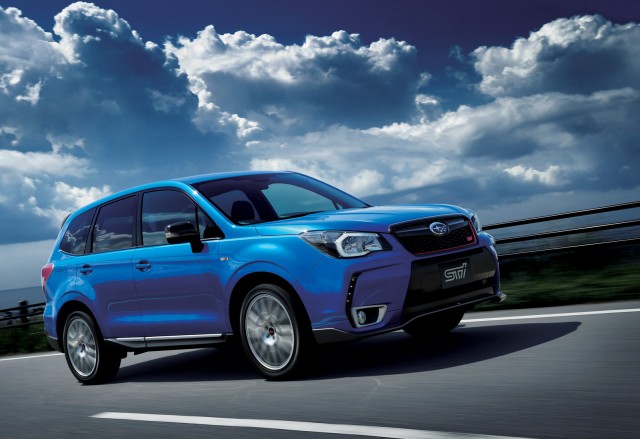The Honda CR-V and the Subaru Forester are two of the more popular compact crossover wagons and are hardy perennials in this segment
These two models, and nearly all the models in their very popular category are great family choices. They can multitask better than most, tucking away up to five passengers and some big-box bargains, all with the promise of all-weather traction and tractability — and with a low sticker price plus some impressive fuel economy numbers.
| vs |
 2015 Subaru Forester 2015 Subaru Forester
|
|||
|---|---|---|---|---|
| Vehicle | 2015 Honda CR-V | Advantage | 2015 Subaru Forester | |
| Engine | 2.4 L Four-Cylinder | – | 2.5 L Four Cylinder | |
| Transmission | CVT | – | CVT | |
| Horsepower | 185 HP | CR-V | 170 HP | |
| Torque | 181 lb-ft. | CR-V | 174 lb-ft. | |
| Weight | 3,521 lbs. | Forester | 3,366 lbs. | |
| Rear Legroom | 38.2 inches | – | 38 inches | |
| Cargo Space (seats up) | 35.2 cubic feet (no split fold) | CR-V | 34.4 cubic feet | |
| Cargo Space (seats down) | 70.9 cubic feet | Forester | 74.7 cubic feet |
But which one offers the better mix of utility and other important features, like safety?
We’ll get to that, but in the meantime it’s worth recognizing that styling is neither ute’s strong point. The Forester’s more handsome than in the past, and the cockpit has a smart functionality to it that transcends its uninteresting design. It’s far from runway material, but the simple design is refreshing and the cabin’s trimmed out to a good, sturdy standard. The CR-V lacks excitement, to be sure, but it at least has a more confident look to it these days, with a tapered rear glass that makes it easier to identify in crowded parking lots. We give the nod to the Forester, because its careful styling nets big visibility gains, while the Honda’s blocky rear pillars steps in the way of a clear view to the rear.
What’s under the hood of the CR-V has always been quite conservative, but it fits the mission; and this year Honda has fitted the CR-V with the latest direct-injection 2.4-liter four-cylinder engine and continuously variable automatic transmission (CVT), from the Accord sedans. The new powertrain brings a smoother, more confident feel under everyday driving, but it still doesn’t feel sporty. EPA fuel economy numbers improve by 3 mpg, though—to 27 mpg city, 34 highway (or 26/33 with all-wheel drive). The CR-V keeps an even keel with handling, too; it doesn’t steer or respond with much verve, and its lighter-duty all-wheel-drive option is optimized for snow and mud, at a maximum.
The basic Forester? It’s no lightning bolt either, but its flat four-cylinder can be turbocharged for 250 horsepower and truly brisk acceleration. A manual transmission is standard on the base wagon, but most other versions sport a continuously variable automatic transmission (CVT) programmed with shift points that mimic a six- or eight-speed automatic. Fuel economy lags the Honda, at 29 or 28 mpg, depending on the drivetrain, but we’ve consistently hit Subaru’s combined numbers in our six-month road test. The Forester’s handling is superior to the Honda’s too, and it has actual trail prowess, with its 8.7 inches of ground clearance and standard all-wheel drive.
The Forester’s interior space is close to that of the Honda, but the CR-V’s smart seat-folding system gets kudos. Open one of the back doors, and with one arm and a simple pull of a strap, in a very fluid motion the lower cushion tumbles forward into the footwell, the headrest angles forward, and the rear seatback flips forward, all tucking nearly behind the front seat, to a completely flat position. The Forester has more vertical space and fold-down rear seats with one-touch action, but the seats don’t quite fold flat. Both have a lot of small-item storage.
Safety was as recently as last year a defining split between these two models, but it’s far closer to a tossup between the two this year. Thanks to some reengineering of the CR-V’s front crash structure, it’s now earned a top ‘good’ rating in the IIHS small overlap frontal test. The CR-V earns great scores from the NHTSA as well. The Forester has standard all-wheel drive, a rearview camera, and nearly perfect crash-test scores from both agencies. And this year the CR-V EX and above includes Honda’s excellent LaneWatch system, which shows a wide-angle view of the lane to the right. If you really want a tie-breaker, we’ll give props to the Forester, which widely offers its camera-based EyeSight suite of forward-collision warning systems (it’s actually cut $500 from the option price this year); meanwhile, the CR-V’s available Lane Keeping Assist.
Equipment varies by model, but all CR-Vs and Foresters include the power and entertainment basics. On the CR-V, more of the optional features we like are tucked away in the most expensive EX-L model. The Forester’s Limited package is more affordable, and offers leather and a power tailgate. Neither crossover has a very good infotainment setup, although the CR-V’s system has been upgraded to the latest 7-inch touchscreen system for 2015, including a Pandora app and SMS texting compatibility. We expect that Subaru’s new interface will make an appearance on the Forester soon.
The CR-V stands out for its better fuel economy numbers and, for now, a somewhat better infotainment system. But the Forester has a slight edge in interior appointments, and it does better in performance for its sprightly (and still affordable) turbocharged models and more engaging handling; it also steps off with its best safety package at a lower price. It’s certainly no landslide, but altogether, that makes the Forester the winner in this crossover face-off.





 2015 Honda CR-V
2015 Honda CR-V


